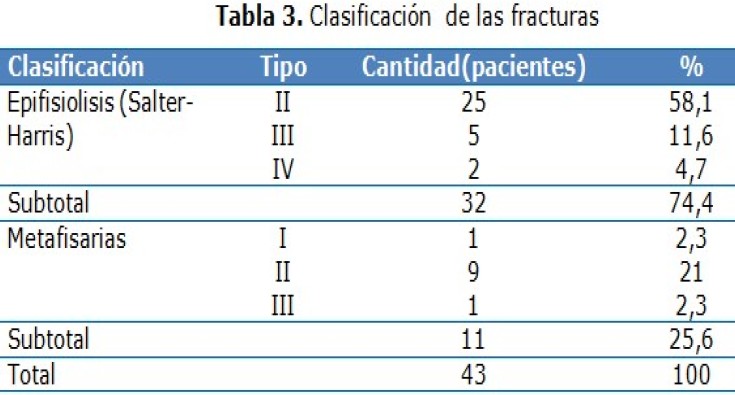Tratamiento de las fracturas del extremo proximal del húmero en niños
Resumen
Fundamento: las fracturas proximales de húmero en niños incluyen la epífisis y las metafisiarias, que son lesiones poco frecuente durante la infancia.Objetivo: evaluar el comportamiento de los niños con fracturas del extremo proximal del húmero.
Métodos: se realizó un estudio longitudinal y descriptivo en 43 pacientes con el diagnóstico de fracturas del húmero proximal, atendidos por el servicio de Ortopedia y Traumatología del Hospital Pediátrico Universitario Eduardo Agramonte Piña, desde marzo 2011 hasta marzo 2014.
Resultados: las fracturas del húmero proximal predominaron en los varones entre 10 y 13 años y el traumatismo por accidente en el hogar, las epifisiolisis fueron más frecuente en la segunda década de la vida y las meafisarias en la primera, el tratamiento conservador fue el más usado en la mayor parte de los pacientes con resultados satisfactorios y las complicaciones fueron mínimas.
Conclusiones: las lesiones de la epífisis humeral superior pueden ocurrir en cualquier edad, mientras esté abierta la fisis, tienen una evolución benigna, por el alto potencial de remodelación de la epífisis.
DeCS: FRACTURAS DEL HÚMERO; ACCIDENTES DOMÉSTICOS; TERAPÉUTICA; NIÑO; ESTUDIOS LONGITUDINALES.
Descargas

Publicado
Cómo citar
Número
Sección
Licencia
La Revista Archivo Medico Camagüey, ofrece de forma inmediata después de ser indexada en el Proyecto SciELO; acceso abierto al texto completo de los artículos bajo el principio de hacer disponible y gratuita la investigación para favorecer el intercambio del conocimiento global y coadyuvar a una mayor extensión, publicación, evaluación y uso extensivo de los artículos que se exponen pudiendo ser utilizados, sin fines comerciales, siempre y cuando se haga referencia a la fuente primaria.
Carta De Declaración De Autoría u Derechos De Autor(a)
Conflictos de intereses: los autores deberán declarar de forma obligatoria la presencia o no de conflictos de intereses en relación con la investigación presentada. (Descargar Plantilla para declarar confictos de intereses)
La Revista Archivo Médico Camagüey se encuentra bajo una
Licencia Creative Commons Reconocimiento-NoComercial 4.0 International (CC BY NC 4.0).
Esta licencia permite a otros distribuir, mezclar, ajustar y construir a partir de su obra, incluso con fines comerciales, siempre que le sea reconocida la autoría de la creación original. Esta es la licencia más servicial de las ofrecidas. Recomendada para una máxima difusión y utilización de los materiales sujetos a la licencia. La licencia completa puede consultarse en: https://creativecommons.org/licenses/












